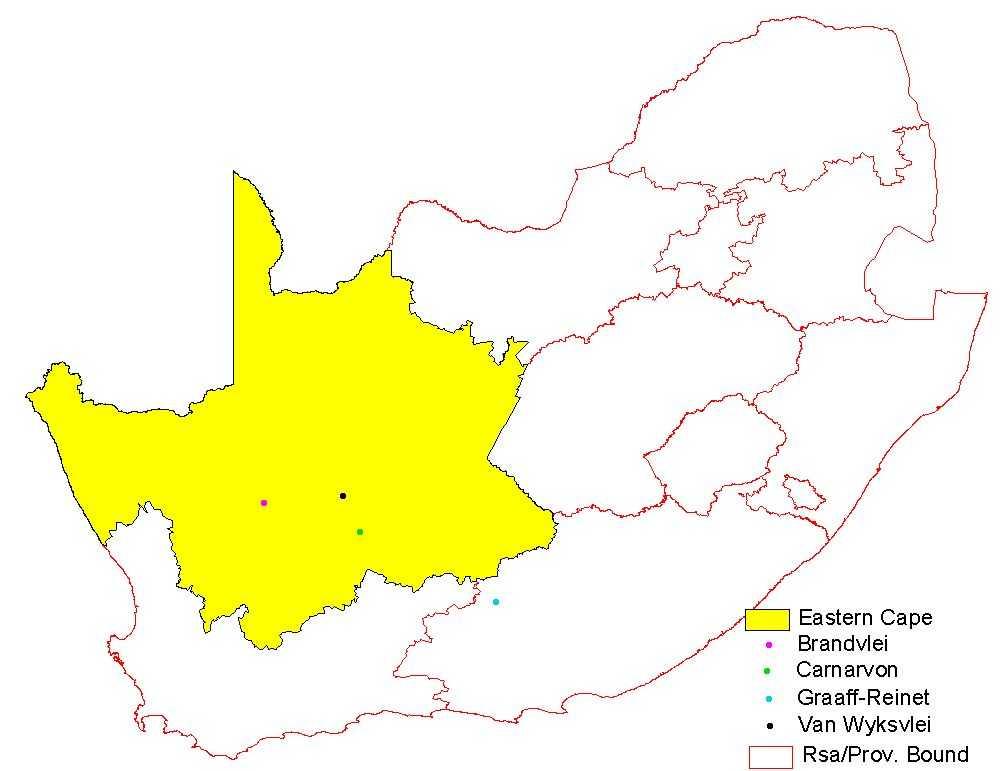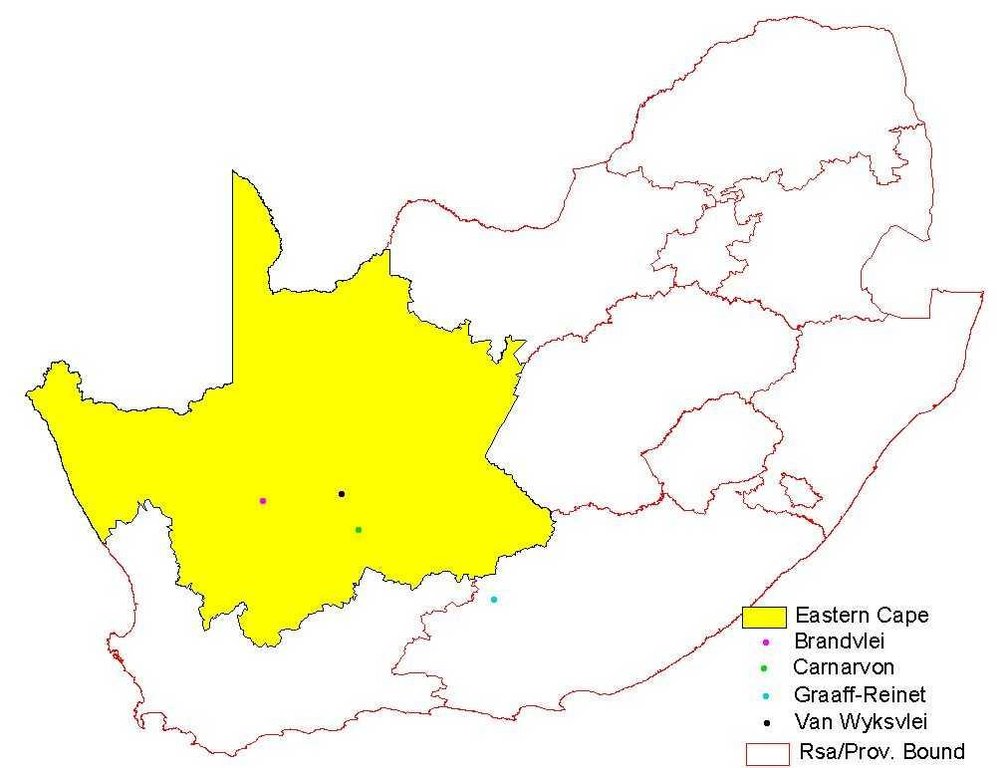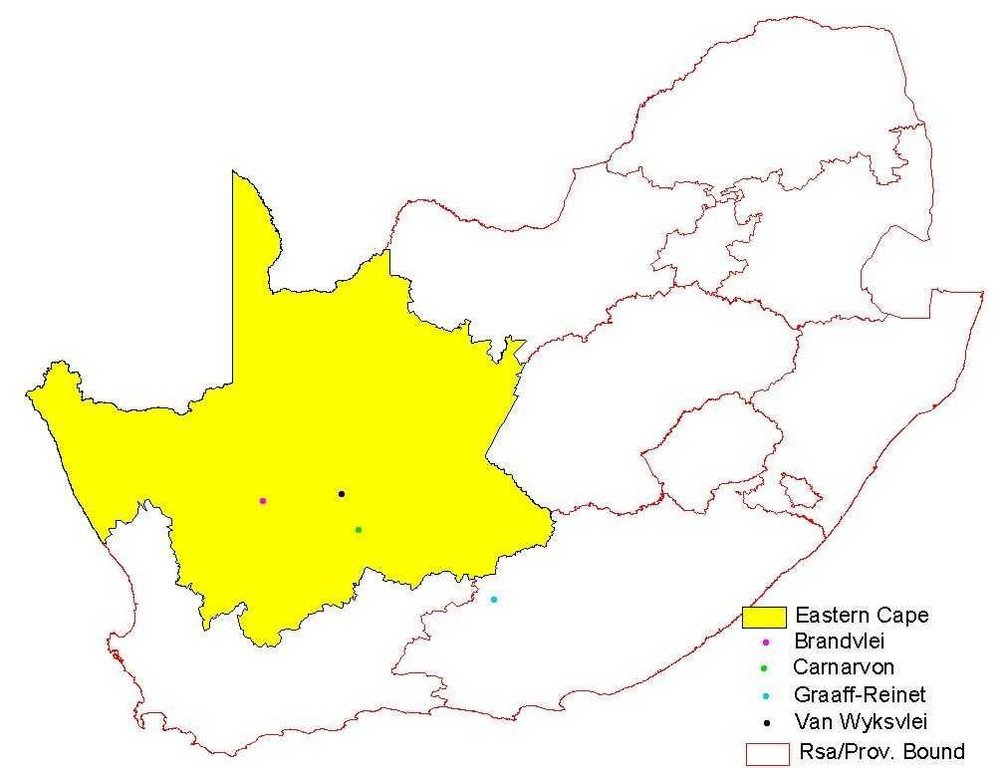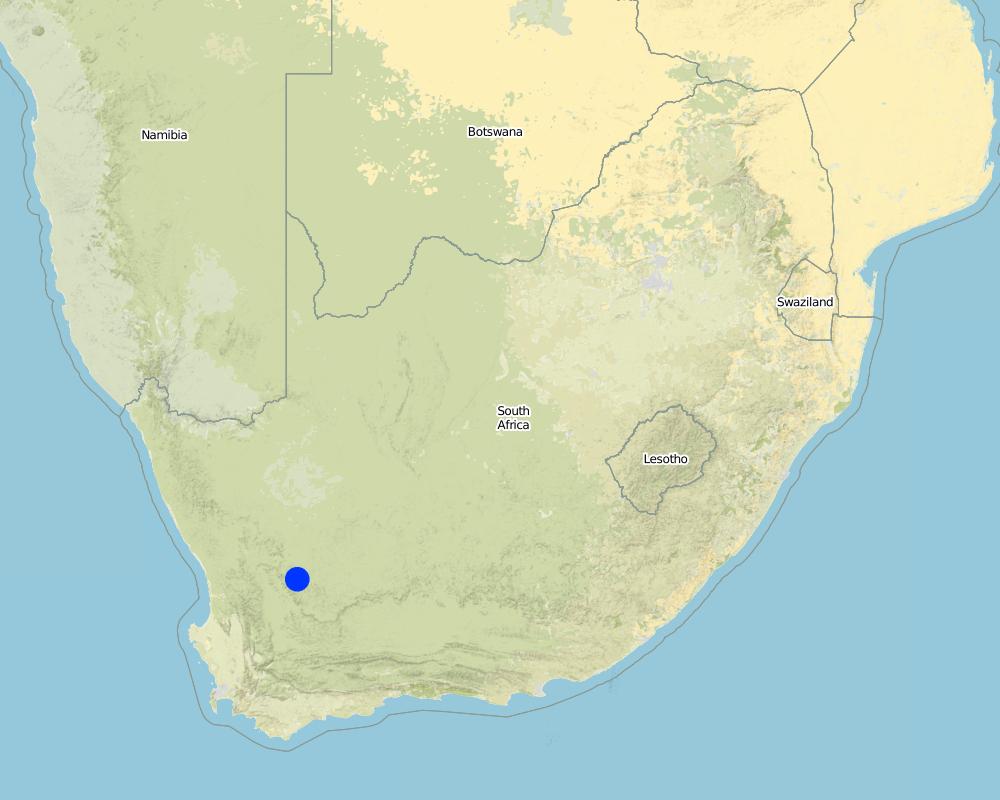Spontaneous adoption [南非]
- 创建:
- 更新:
- 编制者: Philippe Zahner
- 编辑者: –
- 审查者: Fabian Ottiger
approaches_2646 - 南非
查看章节
全部展开 全部收起1. 一般信息
1.2 参与方法评估和文件编制的资源人员和机构的联系方式
有助于对方法进行记录/评估的机构名称(如相关)
Swiss Agency for Development and Cooperation (DEZA / COSUDE / DDC / SDC) - 瑞士1.3 关于使用通过WOCAT记录的数据的条件
编制者和关键资源人员接受有关使用通过WOCAT记录数据的条件。:
是
2. SLM方法的描述
2.1 该方法的简要说明
The farmer made a request to the extension office to advise him on how to rehabilitate a barren area on his farm.
2.2 该方法的详细说明
该方法的详细说明:
Aims / objectives: A farmer contacted the extension office, which investigated and then recommended establishing and planting of Atriplex Nummalaria as a fodder crop and ground cover on the barren area. The farmer was given the necessary information on how to proceed. There is no waiting list. This place was the first one in South Africa where this method was used in the field. The research and adaptations were done at Grootfontein.
2.3 该方法的照片
2.5 采用该方法的国家/地区/地点
国家:
南非
区域/州/省:
Eastern Cape
Map
×2.6 该方法的开始和终止日期
终止年份(若不再采用该方法):
1998
2.7 方法的类型
- 基于项目/方案
2.8 该方法的主要目的/目标
The Approach focused on SLM only
To equip the farmer with the necessary information and data to implement the technology. Information: technician drawing the roads, how much plants and how often they must be irrigated.
The SLM Approach addressed the following problems: Lack of expert knowledge by farmer and inexperience labour; cost of establishing crop
2.9 推动或妨碍实施本办法所适用的技术的条件
社会/文化/宗教规范和价值观
- 阻碍
Project couldn't be finished in a short period (in 1 year no returns)
Treatment through the SLM Approach: Project was stretch over a period of 3 years
法律框架(土地使用权、土地和水使用权)
- 启动
The existing land ownership, land use rights / water rights moderately helped the approach implementation: hinder: low
了解SLM,获得技术支持
- 阻碍
Farmer needed advice
Treatment through the SLM Approach: Extension office provided expertise
3. 相关利益相关者的参与和角色
3.1 该方法涉及的利益相关者及其职责
- 当地土地使用者/当地社区
Land owner
- 国家政府(规划者、决策者)
Extension officer
Working land users were mainly men. Men are the landowners hence only them got involved.
- 国际组织
如果涉及多个利益相关者,请注明领导机构:
Farmer request advise from extension officer, got all the necessary, decision how to go on was taken together.
3.2 当地土地使用者/当地社区参与该方法的不同阶段
| 当地土地使用者/当地社区的参与 | 指定参与人员并描述活动 | |
|---|---|---|
| 启动/动机 | 无 | |
| 计划 | 无 | |
| 实施 | 无 | |
| 监测/评估 | 无 | |
| Research | 无 |
3.4 有关SLM技术选择的决策
具体说明谁有权决定选择要实施的技术:
- 主要是土地使用者,由SLM专家提供支持
解释:
consultative.
Decisions on the method of implementing the SLM Technology were made by mainly by land users supported by SLM specialists. consultative/land user driven.
4. 技术支持、能力建设和知识管理
4.1 能力建设/培训
是否为土地使用者/其他利益相关者提供培训?:
是
培训形式:
- 示范区域
4.2 咨询服务
土地使用者有权使用咨询服务吗?:
是
指明是否提供了咨询服务:
- 在固定中心
说明/注释:
Key elements: give advise, give knowledge; 1) Advisory service was carried out through: government's existing extension system 2) Advisory service was carried out through: government's existing extension system; Extension staff: mainly government employees 3) Target groups for extension: land users; Activities: Advisory
Advisory service is quite adequate to ensure the continuation of land conservation activities
4.3 机构强化(组织发展)
是否通过这种方法建立或加强了机构?:
- 否
4.4 监测和评估
监测和评估是该方法的一部分吗?:
是
注释:
economic / production aspects were regular monitored through measurements
area treated aspects were regular monitored through measurements
There were no changes in the Approach as a result of monitoring and evaluation
4.5 研究
研究是该方法的一部分吗?
是
明确话题:
- 生态学
提供进一步的细节,并指出是谁做的研究:
Research was done by Grootfontein Agricultural Institute on Atriplex nummelaria as a supplementary feed.
Research was carried out on station
5. 融资和外部物质支持
5.1 该方法中SLM组成部分的年度预算
注释(例如主要的资助来源/主要捐助者):
Approach costs were met by the following donors: other (Land owner): 100.0%
The service (extension officer) is free of charge, also the Information from Grootfontein
5.2 为土地使用者提供财政/物质支援
土地使用者是否获得实施该技术的财政/物质支持?:
否
5.3 对特定投入的补贴(包括劳动力)
如果土地使用者的劳动力是一项重要的投入,那么是不是:
- 自愿
5.4 信用
是否根据SLM活动的方法给予信用值?:
否
6. 影响分析和结论性陈述
6.1 方法的影响
该方法是否帮助土地使用者实施和维护SLM技术?:
- 否
- 是,很少
- 是,中等
- 是,支持力度很大
With knowledge he could better manage
该方法是否改善了阻碍SLM技术实施的土地使用权/用户权问题?:
- 否
- 是,很少
- 是,中等
- 是,支持力度很大
The problem is unlikely to be overcome in the near future. Easier just to work with one owner
Did other land users / projects adopt the Approach?
- 否
- 是,很少
- 是,中等
- 是,支持力度很大
80-90% of the farmers usually come to the extension officer, farmer phone for information and invites the extension officer for a visit and share then information about the area.
6.3 方法活动的可持续性
土地使用者能否维持通过该方法实施的措施(无外部支持的情况下)?:
- 是
6.4 该方法的长处/优点
| 土地使用者眼中的长处/优势/机会 |
|---|
| Participation in decision making |
| Gain knowledge |
| 编制者或其他关键资源人员认为的长处/优势/机会 |
|---|
| Landowner is part of decision making |
| Land users participation in increasing productivity of unproductive land |
| Make landowner aware of conservation and a good management system because of the costs involve in rehabilitation |
6.5 该方法的弱点/缺点以及克服它们的方法
| 土地使用者认为的弱点/缺点/风险 | 如何克服它们? |
|---|---|
| Lack of knowledge |
| 编制者或其他关键资源人员认为的弱点/缺点/风险 | 如何克服它们? |
|---|---|
| Expert knowledge is needed | |
| The land user must be aware of a problem and then approach the specialist |
7. 参考和链接
7.1 方法/信息来源
- 实地考察、实地调查
- 与土地使用者的访谈
链接和模块
全部展开 全部收起链接
无链接
模块
无模块





